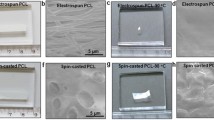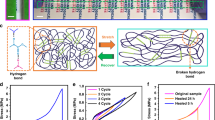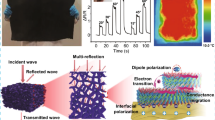Abstract
The elastic conductor is crucial in wearable electronics and soft robotics. The ideal intrinsic elastic bulk conductors show uniform three-dimensional conductive networks and stable resistance during large stretch. A challenge is that the variation of resistance is high under deformation due to disconnection of conductive pathway for bulk elastic conductors. Our strategy is to introduce buckled structure into the conductive network, by self-assembly of a carbon nanotube layer on the interconnecting micropore surface of a prestrained foam, followed by strain relaxation. Both unfolding of buckles and flattening of micropores contributed to the stability of the resistance under deformation (2.0% resistance variation under 70% strain). Microstructural analysis and finite element analysis illustrated different patterns of two-dimensional buckling structures could be obtained due to the imperfections in the conductive layer. Applications as all-directional interconnects, stretchable electromagnetic interference shielding and electrothermal tumor ablation were demonstrated.
摘要
弹性导体在可穿戴电子设备和软机器人中至关重要. 理想的本征弹性体导体在大形变下显示出均匀的三维导电网络结构和稳定的电阻变化. 其面临的一个挑战是, 由于体弹性导体在形变下导电路径断开, 电阻变化很大. 我们的策略是将具有互连微孔的泡沫进行预拉伸, 通过碳纳米管在微孔表面自组装形成导电层, 随后释放预应变, 从而在导电网络中引入褶皱结构. 在拉伸过程中, 褶皱和微孔的变形都有助于电阻的稳定(在70%应变下电阻变化2.0%). 微观结构和有限元分析表明, 由于导电层中的缺陷, 可以获得不同形貌的二维褶皱结构. 我们展示了其在全方位电气互连、 可拉伸电磁屏蔽和电热肿瘤消融方面的应用.
Similar content being viewed by others
References
Hwang BU, Lee JH, Trung TQ, et al. Transparent stretchable self-powered patchable sensor platform with ultrasensitive recognition of human activities. ACS Nano, 2015, 1: 8801–8810
Jeong CK, Lee J, Han S, et al. A hyper-stretchable elastic-composite energy harvester. Adv Mater, 2015, 1: 2866–2875
Kim KK, Hong S, Cho HM, et al. Highly sensitive and stretchable multidimensional strain sensor with prestrained anisotropic metal nanowire percolation networks. Nano Lett, 2015, 1: 5240–5247
Han S, Hong S, Ham J, et al. Fast plasmonic laser nanowelding for a Cu-nanowire percolation network for flexible transparent conductors and stretchable electronics. Adv Mater, 2014, 1: 5808–5814
Xu F, Zhu Y. Highly conductive and stretchable silver nanowire conductors. Adv Mater, 2012, 1: 5117–5122
Hansen T, West K, Hassager O, et al. Highly stretchable and conductive polymer material made from poly(3,4-ethylene-dioxythiophene) and polyurethane elastomers. Adv Funct Mater, 2007, 1: 3069–3073
Lee YY, Kang HY, Gwon SH, et al. A strain-insensitive stretchable electronic conductor: PEDOT:PSS/acrylamide organogels. Adv Mater, 2016, 1: 1636–1643
Markvicka EJ, Bartlett MD, Huang X, et al. An autonomously electrically self-healing liquid metal-elastomer composite for robust soft-matter robotics and electronics. Nat Mater, 2018, 1: 618–624
Yun G, Tang SY, Sun S, et al. Liquid metal-filled magnetorheological elastomer with positive piezoconductivity. Nat Commun, 2019, 10: 1300
Chun KY, Oh Y, Rho J, et al. Highly conductive, printable and stretchable composite films of carbon nanotubes and silver. Nat Nanotech, 2010, 1: 853–857
Matsuhisa N, Kaltenbrunner M, Yokota T, et al. Printable elastic conductors with a high conductivity for electronic textile applications. Nat Commun, 2015, 6: 7461
Hong S, Lee H, Lee J, et al. Highly stretchable and transparent metal nanowire heater for wearable electronics applications. Adv Mater, 2015, 1: 4744–4751
Jung J, Lee H, Ha I, et al. Highly stretchable and transparent electromagnetic interference shielding film based on silver nanowire percolation network for wearable electronics applications. ACS Appl Mater Interfaces, 2017, 1: 44609–44616
Lipomi DJ, Lee JA, Vosgueritchian M, et al. Electronic properties of transparent conductive films of PEDOT:PSS on stretchable substrates. Chem Mater, 2012, 1: 373–382
Vosgueritchian M, Lipomi DJ, Bao Z. Highly conductive and transparent PEDOT:PSS films with a fluorosurfactant for stretchable and flexible transparent electrodes. Adv Funct Mater, 2012, 1: 421–428
Yao S, Zhu Y. Nanomaterial-enabled stretchable conductors: Strategies, materials and devices. Adv Mater, 2015, 1: 1480–1511
Bartlett MD, Markvicka EJ, Majidi C. Rapid fabrication of soft, multilayered electronics for wearable biomonitoring. Adv Funct Mater, 2016, 1: 8496–8504
Kim DH, Lu N, Ma R, et al. Epidermal electronics. Science, 2011, 1: 838–843
Jeong H, Wang L, Ha T, et al. Modular and reconfigurable wireless E-tattoos for personalized sensing. Adv Mater Technol, 2019, 4: 1900117
Kim A, Ahn J, Hwang H, et al. A pre-strain strategy for developing a highly stretchable and foldable one-dimensional conductive cord based on a Ag nanowire network. Nanoscale, 2017, 1: 5773–5778
Lee P, Lee J, Lee H, et al. Highly stretchable and highly conductive metal electrode by very long metal nanowire percolation network. Adv Mater, 2012, 1: 3326–3332
Liu ZF, Fang S, Moura FA, et al. Hierarchically buckled sheath-core fibers for superelastic electronics, sensors, and muscles. Science, 2015, 1: 400–404
Zhu Y, Xu F. Buckling of aligned carbon nanotubes as stretchable conductors: A new manufacturing strategy. Adv Mater, 2012, 1: 1073–1077
Greco F, Fujie T, Ricotti L, et al. Microwrinkled conducting polymer interface for anisotropic multicellular alignment. ACS Appl Mater Interfaces, 2013, 1: 573–584
Trung TQ, Lee NE. Recent progress on stretchable electronic devices with intrinsically stretchable components. Adv Mater, 2017, 29: 1603167
Liu Z, Wan F, Mou L, et al. A general approach for buckled bulk composites by combined biaxial stretch and layer-by-layer deposition and their electrical and electromagnetic applications. Adv Electron Mater, 2019, 5: 1800817
Weng C, Dai Z, Wang G, et al. Elastomer-free, stretchable, and conformable silver nanowire conductors enabled by three-dimensional buckled microstructures. ACS Appl Mater Interfaces, 2019, 1: 6541–6549
O’Connell MJ, Boul P, Ericson LM, et al. Reversible water-solubilization of single-walled carbon nanotubes by polymer wrapping. Chem Phys Lett, 2001, 1: 265–271
Thomas AV, Andow BC, Suresh S, et al. Controlled crumpling of graphene oxide films for tunable optical transmittance. Adv Mater, 2015, 1: 3256–3265
Yu Y, Zeng J, Chen C, et al. Three-dimensional compressible and stretchable conductive composites. Adv Mater, 2014, 1: 810–815
Ge J, Yao HB, Wang X, et al. Stretchable conductors based on silver nanowires: improved performance through a binary network design. Angew Chem Int Ed, 2013, 1: 1654–1659
Wu C, Fang L, Huang X, et al. Three-dimensional highly conductive graphene-silver nanowire hybrid foams for flexible and stretchable conductors. ACS Appl Mater Interfaces, 2014, 1: 21026–21034
Duan S, Wang Z, Zhang L, et al. Three-dimensional highly stretchable conductors from elastic fiber mat with conductive polymer coating. ACS Appl Mater Interfaces, 2017, 1: 30772–30778
Tang Y, Gong S, Chen Y, et al. Manufacturable conducting rubber ambers and stretchable conductors from copper nanowire aerogel monoliths. ACS Nano, 2014, 1: 5707–5714
Kim KH, Vural M, Islam MF. Single-walled carbon nanotube aerogel-based elastic conductors. Adv Mater, 2011, 1: 2865–2869
Gao HL, Xu L, Long F, et al. Macroscopic free-standing hierarchical 3D architectures assembled from silver nanowires by ice templating. Angew Chem Int Ed, 2014, 1: 4561–4566
Oh JY, Lee D, Hong SH. Ice-templated bimodal-porous silver nanowire/PDMS nanocomposites for stretchable conductor. ACS Appl Mater Interfaces, 2018, 1: 21666–21671
Chen Z, Ren W, Gao L, et al. Three-dimensional flexible and conductive interconnected graphene networks grown by chemical vapour deposition. Nat Mater, 2011, 1: 424–428
Chortos A, Liu J, Bao Z. Pursuing prosthetic electronic skin. Nat Mater, 2016, 1: 937–950
Lipomi DJ, Vosgueritchian M, Tee BCK, et al. Skin-like pressure and strain sensors based on transparent elastic films of carbon nanotubes. Nat Nanotech, 2011, 1: 788–792
Mates JE, Bayer IS, Palumbo JM, et al. Extremely stretchable and conductive water-repellent coatings for low-cost ultra-flexible electronics. Nat Commun, 2015, 6: 8874
Chen Z, Xu C, Ma C, et al. Lightweight and flexible graphene foam composites for high-performance electromagnetic interference shielding. Adv Mater, 2013, 1: 1296–1300
Wan YJ, Zhu PL, Yu SH, et al. Anticorrosive, ultralight, and flexible carbon-wrapped metallic nanowire hybrid sponges for highly efficient electromagnetic interference shielding. Small, 2018, 14: 1800534
Chu KF, Dupuy DE. Thermal ablation of tumours: biological mechanisms and advances in therapy. Nat Rev Cancer, 2014, 1: 199–208
Sotiriou GA, Starsich F, Dasargyri A, et al. Photothermal killing of cancer cells by the controlled plasmonic coupling of silica-coated Au/Fe2O3 nanoaggregates. Adv Funct Mater, 2014, 1: 2818–2827
Zhou Y, Wang R, Teng Z, et al. Magnetic nanoparticle-promoted droplet vaporization for in vivo stimuli-responsive cancer theranostics. NPG Asia Mater, 2016, 8: e313
Svirskis D, Travas-Sejdic J, Rodgers A, et al. Electrochemically controlled drug delivery based on intrinsically conducting polymers. J Control Release, 2010, 1: 6–15
Acknowledgements
This work was supported by the National Key Research and Development Program of China (2017YFB0307000), the National Natural Science Foundation of China (51973093, U1533122 and 51773094), the Natural Science Foundation of Tianjin (18JCZDJC36800), the Science Foundation for Distinguished Young Scholars of Tianjin (18JCJQJC46600), the Fundamental Research Funds for the Central Universities (63171219), the State Key Laboratory for Modification of Chemical Fibers and Polymer Materials, Donghua University (LK1704), the National Special Support Plan for High-level Talents people (C041800902), and the Eugene McDermott Graduate Fellows Program.
Author information
Authors and Affiliations
Contributions
Author contributions Liu ZF was responsible for the experimental concept and design. He W, Cheng Y, Zhou X, Hu X, Liu ZS, Sun J and Wang Y carried out the most of the experiments, characterization and data analyses. Zhang R, Qian D and Liu ZJ contributed to the theoretical simulation and calculation. Zhang C carried out the cell viability experiments and data analyses. All authors contributed to the general discussion. All authors provided comments and agreed with the final form of the manuscript.
Corresponding author
Additional information
Conflict of interest The authors declare that they have no conflict of interest.
Wenqian He is currently a MSc candidate under the supervision of Prof. Zunfeng Liu at the State Key Laboratory of Medicinal Chemical Biology, Nankai University. Her research interest focuses on the intrinsic elastic conductor for flexible wearable electronics.
Zunfeng Liu is a professor at the Key Laboratory of Functional Polymer Materials, College of Pharmacy and the State Key Laboratory of Medicinal Chemical Biology, Nankai University. He received his PhD from Nankai University in 2008. From 2008 to 2012, he was working as a postdoc fellow and project leader in Erasmus Medical Center, Leiden University (Netherlands). From 2013 to 2016, he was a professor at Changzhou University. His research expertise is in the area of wearable electronics, artificial muscles and actuators, especially in developing highly stretchable electronic interconnects, sensors and medical devices.
Supporting Information
40843_2020_1266_MOESM1_ESM.pdf
Intrinsic Elastic Conductors with Internal Buckled Electron Pathway for Flexible Electromagnetic Interference Shielding and Tumor Ablation
Supplementary material, approximately 1.41 MB.
Supplementary material, approximately 2.78 MB.
Supplementary material, approximately 14.1 MB.
Supplementary material, approximately 9.83 MB.
Rights and permissions
About this article
Cite this article
He, W., Zhang, R., Cheng, Y. et al. Intrinsic elastic conductors with internal buckled electron pathway for flexible electromagnetic interference shielding and tumor ablation. Sci. China Mater. 63, 1318–1329 (2020). https://doi.org/10.1007/s40843-020-1266-9
Received:
Accepted:
Published:
Issue Date:
DOI: https://doi.org/10.1007/s40843-020-1266-9




